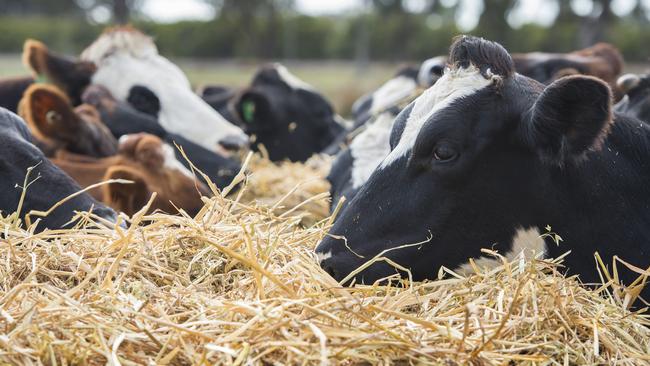Hay market flatlines, grain crops at mercy of weather
Hay growers must remain patient as prices stagnate in a buyer’s market, while volatility rattles grain market.

Dairy farmers are seeing spirited bidding for their milk, but hay growers are not getting knocked over by demand this winter.
Hay demand has picked up as is typical for this time of the year yet hay prices remain flat.
Sheep producers in southern Victoria are hunting out some vetch hay for feeding to lambing ewes. While rainfall is above average at present, the break was late in some places and the wedge of feed is less than normal.
According to hay traders, buyers are looking for the high-quality vetch selling for more than $220 a tonne ex-Wimmera farm, testing at least 20 per cent protein and 10 ME units of energy, right through to the lower priced lines selling at $140 a tonne and testing 17 per cent protein and 8 ME units of energy.
Week in and week out, cereal hay prices have moved little this season. Since the middle of September last year, cereal hay prices have stayed within the same $15 a tonne trading range. Vetch and pasture hay also have been selling in a small range.
It has been a buyer’s market and for a change, dairy farmers do not have hay at the top of their lists of high input costs for their enterprises.
Hay growers have had to be patient. Sales have not come as freely as they have during the past five years. Sellers would like the chance to clear their stocks before new-crop and remove mice as a future threat.
Mice are present in many Wimmera hay stacks, but baiting is keeping on top of the populations.
The only other 10-month period when hay prices have remained as stagnant as this was in the high-yielding, wet season of 2010-11.
Cereal hay crops were yielding more than eight tonnes a hectare and the incessant rain during October and November of 2011 ensured the hay quality and prices were low.
Back then, cereal hay prices traded within $15 of an average price of $120 a tonne for the 14 months from August 2010 to October 2011.
In this season, quality is also low due to rain damage at curing, but at least growers have a base price that is $75 a tonne higher.
Hay growers and traders are speculating when hay prices will be dragged out of this price rut.
There are still good margins in hay if sales can be achieved.
Graziers south of the Great Divide with wet paddocks require careful management, so they do not pug soils and reduce pasture growth. This is especially the case for those with properties between Ballarat and Hamilton and in eastern Gippsland where decile 10 rainfall fell last month.
There is a lot of winter to go, climate models are hinting at above-average rainfall this winter and more heavy rain is not what many are looking for.
FOREIGN AND DOMESTIC CROPS AT MERCY OF WEATHER
Crops are at a critical stage in the northern hemisphere and a series of reports have maintained the volatility of a market focused on weather.
The US Department of Agriculture’s planted area update from last week sent the buyers into the market as the corn area of 92.7 million acres (37.5 million ha) was well below trader’s expectations.
Cold and wet weather in the EU and Black Sea region during the harvest of winter crops is concerning for grain quality and markets have responded.
This week opens with wheat futures in Chicago up $4 a tonne, Paris up $5.90 a tonne and the ASX up $10 a tonne.
Local cash prices are $5 higher for new-crop with trader bids for Australian Premium White wheat at $309 a tonne on a Geelong port basis.
Australian wheat prices remain constrained by the cheap grain exported through the Black Sea ports.
Much needed rain fell in Central Russia and northern Kazakhstan, supporting the drought affected spring wheat crops. Winter cereal crops for the Black Sea exporters are performing well and prices are easing.
The development of Victorian grain crops is also diverse.

Wheat and barley crops in the northern Mallee are only just out of the ground at one to two leaf stage and ticking along with minimal moisture.
Further south, wheat crops near Lismore that were planted in March are 30cm high and showing signs of water logging and yellowing despite adequate applications of urea.
All growing areas in Victoria and the Riverina are expecting a relatively dry week with big falls expected in northern NSW and still more rain for the monster crops of Western Australia.
Growers will be pleased with canola prices as new-crop values are back to near seasonal highs at $785 a tonne on a Geelong port basis.
Temperatures in British Columbia have hit record levels and weather on the Canadian Prairies remains hot and dry.
As Canadian canola crops are flowering, yield prospects are dropping dramatically.
Despite a report from Statistics Canada last week that Canadian farmers planted 22.5 million acres, 1 million acres more than last month’s estimate and almost 2 million acres more than last year, Winnipeg February canola futures spiked $60 a tonne.
Pulse crops such as chick peas and lentils are also suffering under the severe growing conditions yet new-crop pulse prices remain unchanged.
Brokers are quoting current crop nugget lentils at $760 a tonne delivered to Melbourne-based packers and new-crop at $740.
MORE
CHINA BECOMES BIGGEST BUYER OF AUSSIE WHEAT


